We previously offered a recipe for Homemade Kimchi (June 26, 2011). It is an excellent recipe, but Shou-Ching wanted to continue experimenting until she reproduced the flavor and texture of her mother’s kimchi that she loved as a child growing up in Korea.
She thinks she’s got it.
Health Benefits of Kimchi
But before we share the recipe, a few reasons to make kimchi. Kimchi has been reported to:
- Reduce body weight and blood pressure in the overweight and obese. [1]
- Inhibit autoimmune diseases such as atopic dermatitis [2]
- Inhibit development of allergy. [3]
- Have anticancer effects. [4]
- Inhibit development of atherosclerosis. [5]
- Have antimicrobial effects on some of the most common gut pathogens, including Listeria, Staphylococcus, Salmonella, Vibrio, and Enterobacter. [6]
Against those benefits, kimchi consumption has been associated with higher rates of stomach cancer [7], perhaps due to its high content of salt [8] or N-nitroso compounds [9].
Homemade kimchi is far superior to store-bought kimchi. To accelerate fermentation, commercial kimchis usually contain sugar, but this means they will go bad soon after exposure to oxygen. Homemade kimchi, without added sugar, can retain its freshness up to several weeks after it is first exposed to air. The mix of bacteria in homemade kimchi may be far more healthful.
Preparing the Kimchi
This version starts with one large head of Chinese or Napa cabbage and the following vegetables:
- A daikon radish
- An equal volume of carrots
- Green onion
- Garlic
- Ginger
Set aside the cabbage for a bit. Shred the radish and carrots in a grater; mince the green onion, garlic, and ginger in a food processor. Add 3 tbsp chili powder:
Mix the vegetables thoroughly and add salt and fish sauce (optional, but we use 1 tbsp of a light fish sauce) to taste:
Cover these vegetables in plastic wrap, to start the fermentation off in the right direction, for a few hours while preparing the cabbage.
Cut the head of cabbage lengthwise in half, and then each half in quarters, all lengthwise:
Then chop along the other direction until the whole cabbage is reduced to bite size pieces.
Transfer the chopped cabbage to a bowl a handful at a time – a handful of cabbage, a teaspoon of salt; a handful of cabbage, a teaspoon of salt; continue transferring cabbage and salt until all the cabbage is in the bowl:
Put a weight on top of the cabbage to compress it and release water:
Wait two hours. Over this time the cabbage will shrink as it loses water:
After two hours, rinse the cabbage in fresh water and put it in a strainer. Take the cabbage in your hands and squeeze water out; then transfer the dehydrated cabbage to the other bowl with the mixed vegetables. Continue until all the cabbage has been transferred.
Mix the cabbage and the other vegetables thoroughly:
Taste the mixture to see if it needs more salt. Transfer everything to a container that can make an airtight seal for the fermentation process.
It is important to create an anaerobic environment, similar to that in the gut. This pyrex bowl with a plastic lid makes an airtight seal:
In case pressure should build up and break the seal, we enclosed the container in a plastic bag:
Leave the sealed container at room temperature in a dark place for four to seven days before opening. It should have a mildly sour (acidic) taste; that signifies the presence of lactic acid from lactic acid generating bacteria.
Serve:
Conclusion
Depending on how much water was squeezed out of the cabbage, the kimchi may be more or less watery. There’s nothing wrong with a watery ferment, but when more water is present, more salt may be needed to achieve an appropriately acidic ferment.
As time goes on, the kimchi will become increasingly sour. When the taste starts to become unpleasant, Koreans cook the kimchi into a soup, killing the bacteria. Some of the benefits of kimchi are retained if the kimchi is cooked. [3]
Although with live cultures anything is possible and a few people may experience digestive disturbances from eating kimchi, many more find that kimchi improves their digestive function. It is an excellent probiotic.
References
[1] Kim EK et al. Fermented kimchi reduces body weight and improves metabolic parameters in overweight and obese patients. Nutr Res. 2011 Jun;31(6):436-43. http://pmid.us/21745625.
[2] Won TJ et al. Therapeutic potential of Lactobacillus plantarum CJLP133 for house-dust mite-induced dermatitis in NC/Nga mice. Cell Immunol. 2012 May-Jun;277(1-2):49-57. http://pmid.us/22726349. Won TJ et al. Oral administration of Lactobacillus strains from Kimchi inhibits atopic dermatitis in NC/Nga mice. J Appl Microbiol. 2011 May;110(5):1195-202. http://pmid.us/21338447.
[3] Hong HJ et al. Differential suppression of heat-killed lactobacilli isolated from kimchi, a Korean traditional food, on airway hyper-responsiveness in mice. J Clin Immunol. 2010 May;30(3):449-58. http://pmid.us/20204477.
[4] Park KY et al. Kimchi and an active component, beta-sitosterol, reduce oncogenic H-Ras(v12)-induced DNA synthesis. J Med Food. 2003 Fall;6(3):151-6. http://pmid.us/14585179.
[5] Kim HJ et al. 3-(4′-hydroxyl-3′,5′-dimethoxyphenyl)propionic acid, an active principle of kimchi, inhibits development of atherosclerosis in rabbits. J Agric Food Chem. 2007 Dec 12;55(25):10486-92. http://pmid.us/18004805.
[6] Kim YS et al. Growth inhibitory effects of kimchi (Korean traditional fermented vegetable product) against Bacillus cereus, Listeria monocytogenes, and Staphylococcus aureus. J Food Prot. 2008 Feb;71(2):325-32. http://pmid.us/18326182. Sheo HJ, Seo YS. The antibacterial action of Chinese cabbage kimchi juice on Staphylococcus aureus, Salmonella enteritidis, Vibrio parahaemolyticus and Enterobacter cloacae. J Korean Soc Food Sci Nutr 2003, 32:1351-1356. Hat tip Rafael Borneo, http://dietasaludperfecta.blogspot.com.ar/2013/03/kimchi-un-superalimento.html.
[7] Zhang YW et al. Effects of dietary factors and the NAT2 acetylator status on gastric cancer in Koreans. Int J Cancer. 2009 Jul 1;125(1):139-45. http://pmid.us/19350634. Nan HM et al. Kimchi and soybean pastes are risk factors of gastric cancer. World J Gastroenterol. 2005 Jun 7;11(21):3175-81. http://pmid.us/15929164.
[8] Lee SA et al. Effect of diet and Helicobacter pylori infection to the risk of early gastric cancer. J Epidemiol. 2003 May;13(3):162-8. http://pmid.us/12749604.
[9] Seel DJ et al. N-nitroso compounds in two nitrosated food products in southwest Korea. Food Chem Toxicol. 1994 Dec;32(12):1117-23. http://pmid.us/7813983.







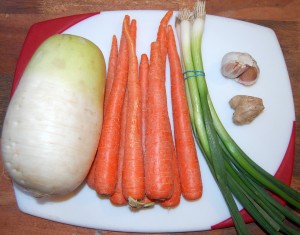

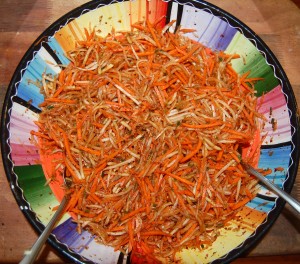

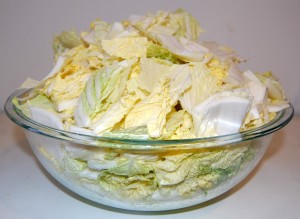
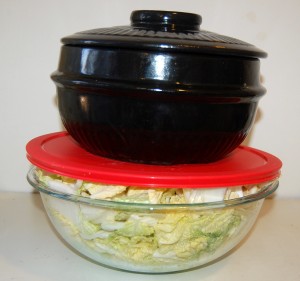
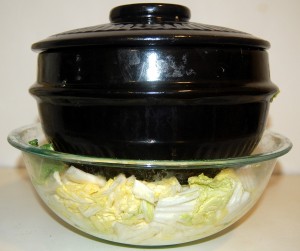
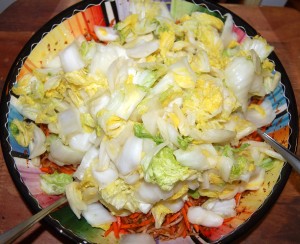
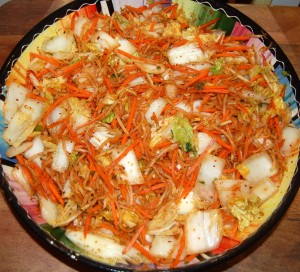
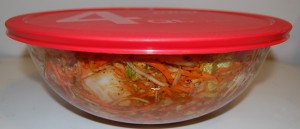
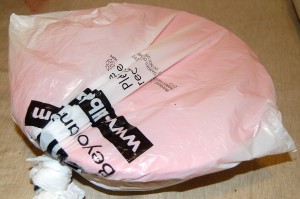
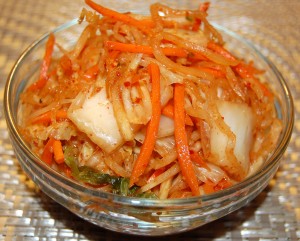




Hi again Paul!
I’m having problems with fermented veggies, or more likely the problem is with my gut bacteria. When I eat it I get really loose stools, bloating and feeling of nausea. I’m sure there is nothing wrong with the product. The fermentation process went beautifully and they taste great.. Could it be that there is some kind of ‘die off’ going in my gut? Sometimes I also have problems digesting lettuce. It just goes thru me seemingly untouched. But that is not always the case.
Should I just continue eating the veggies, but maybe just a tiny bit a day and increase the amount gradually in the following months?
Hi Sakari,
Yes, I like the eat a tiny bit each day strategy. Ultimately increasing bacterial diversity is the solution; but you want to get there with minimal side effects.
Love this recipe! Also check my paleo recipes website.
Thank you!
Shou-Ching, thank you for that. I love kimchi so I’m going to enjoy making this. I can’t wait until your cook book comes out.
Paul, I have pretty exhausted adrenals and use quite a bit of (Himalayan rock) salt in my food, should I be looking to reduce the salt or does adrenals trump stomach cancer.
Thank you!
Hi Lorna,
If you’re urinating salt away due to adrenal dysfunction, you need to replace it. Yes, adrenals trump stomach cancer risk, which is minimal and may not be due to the salt.
This recipe looks really great. One item that seems to be missing is an Asian pear (although any pear will work really, maybe even an apple). I usually mince one up with the onion and garlic. It gives the bacteria some extra fuel to get going and all of the sugars are consumed by the time the fermentation is complete.
Hi Ryan,
The carrots have sugar, so I don’t think it’s necessary. The pear speeds up fermentation a bit and many may prefer the taste, but I’m not sure it’s as good from a microbial ecology perspective.
Just out of curiosity do you think that the extra sugars in the pear lead to an overgrowth of certain bacteria in the mix? Also while on that topic, does the general bacteria mix become less diverse as the kimchi becomes more acidic? In other words is there a more ideal time to eat it than others in regards to adding diversity to your gut?
Hi Ryan,
Yes, I think extra sugars are a risk factor — they favor the fastest reproducing species, rather than a diverse array of species. Pear is of course not nearly as bad as added sugar.
The bacterial mix is generally best at the point when the acidity has become significant and is still rising. This time will have the most lactic acid bacteria and also will retain many of the species that came with the vegetables.
Stop too early in the ferment and some pathogenic species which don’t fare well in an acidic anaerobic environment will be too abundant – it needs acidity to knock them down; wait too long and eventually fungi will take over.
Paul, I often “burp” my kimchi (release the bulit-up gases) every 2 days to keep it from exploding (admittedly, I also use an Asian pear so that might contribute to its volatility); would you recommend against that in order to better preserve the anaerobic environment? I assume so, but wanted to double-check. I guess at some point I’ll have to hunker down and get a Harsch fermentation crock to get the best of both worlds. 😀
Hi Russ,
We haven’t found it to be necessary — no explosions yet. We little a little room for air at the top of the container before sealing.
Paul and Shou-Ching –
Thanks for the recipe..I can’t wait to try it. I made a batch with the other recipe, and it was passable (but not as good as what I get in Korea)!
Quick question: the directions say “An equal volume of carrots”. Equal to….what? The cabbage volume? The radish?
Thanks!
Jim
Hi Jim,
Yes, the radish. Also, roughly the same amount of garlic and ginger.
Help?! How do you know what is growing in the kimchi? Do you use a starter? I understand that people who have been making it might have the right organisms floating around in their kitchen, but what if you’re just starting? Do you ever get a bad batch, I mean you open it and it’s not sour, it’s an awful mess? Or are the right organisms right there in most cabbage to start with? I am really confused about this…
You don’t need a starter. There are microbes all over the place, vegetables come with them. The ones naturally on the vegetables are ones that are capable of feeding on the plant matter, which is what you want. The fermenting process simply creates an environment similar to that in the colon and lets the ones that flourish in that environment multiply and the ones that don’t decrease in number.
Just curious are you using chili peppers, ground into a powder or American style chili powder (aka texas chili).
http://www.penzeys.com/cgi-bin/penzeys/p-penzeyschilipeppers.html
Hi Holly,
We used this:
Singsong Korean Hot Pepper Fine Type Powder, 1.10 Pound
Will it work if I omit the chili peppers? I mean, will it still contain probiotics? The modified paleo diet for autoimmune protocal suggests avoiding chili peppers as they believe it might irritate the gut.
Yes, it will work.
I spent a year in Korea and seem to remember having potatoes in kimchi. I wonder if they were in during the ferment or added after? Really good recipe! I love the stuff. It goes really well with rice.
I’ve never actually had a fermented potato kimchi dish. Although you do get cooked potato side dishes at korean restaurants – usually it’s the sweet one, with cubed potato, diced onions, sesame seeds, garlic, soy sauce and sugar.
Often, you can get radish kimchi though, like this: http://www.maangchi.com/recipe/kkakdugi
Looks like a fantastic recipe. I make Sauerkraut all the time and it is my wife’s favorite when I add some spicy pepper and carrots to it. I think she will love this!
I have never tried to ferment without water. I thought it was necessary to submerge the veggies in water to maintain the anaerobic environment. I haven’t looked on your site, but do you make Sauerkraut this way also?
Thanks
Hi Andy,
There’s still some water in this recipe, and it’s fine to submerge the vegetables in water. We have a “fermented mixed vegetables” recipe you might want to check out for an alternative.
Kimchi is such a staple in my house! Colon cancer runs in the family and we feel that fermented vegetables help ward off potential harmful polyps!
Outstanding!
I’ve been purchasing bottled Kimchi from Whole Foods. This recipe/method looks great.
Thank you, Shou-Ching, for doing your best to reproduce the kimchi from your ancestral past.
KKC
Hi Paul, do you think I can translate this post to spanish and publish it in my blog. I can not find a truly great recipe for good fermented kimchi. Of course you will be properly credited. Thanks
Hi Rafael, yes you can.
will do it soon thanks
Thanks Paul, looks fantastic.
Are Kimchi, sour kraut and other fermented veggies things you can eat during the 16 hour fast that you recommend? I guess you’d probably want to avoid starchy and sugary veggies but if we’re talking about fermented cabbage, for example, is that ok? I’m trying to do the 16 hour fasting and trying to increase the coconut oil. I’m finding it really hard. I can’t just eat coconut oil straight like many of you seem to be doing so I’m trying to find ways to incorporate it into food especially for the 16 hour fast part of the day. I just had some kale cooked in 2 tbs of coconut oil to which I added cumin and turmeric, black pepper and sea salt. When it cooled down, I added some sour kraut because I thought it would be a nice foil for the coconut oil and it was. Then it occurred to me that I should find out if the fermented veggies interfere in anyway with the benefits of the 16 hour fast.
Yes, you can eat them while fasting.
Do you think I can use the “regular” cabbage??
Hi Rafael,
Yes, you can, but we haven’t tried it ourselves. It is sometimes used in Korea, but not as often.
Hi Paul,
Wow, that kimchi looks so good! I can’t wait to make it. Would you or Shou-Ching be able to answer these questions?
1) sometimes when I go to buy Napa cabbage, I see tiny black specks on the outer leaves so I don’t buy it. But I see this often. It does not look like mold or anything like that. Have you seen that? Is it ok to use like that?
2) Is the chili powder just standard chili powder or is it a particular type? When I go to the Asian store, I see the giant bags of chili powder to use for kimchi but it’s mostly all in Korean and I can’t tell if it’s something unique or if it’s just the same as the jar of chili powder I already have?
Thanks!
KH
Hi KH,
1) The spots are called pepper spots, see http://edis.ifas.ufl.edu/hs352. It is OK to eat spotted cabbage.
2) The chili powder we used is Singsong Korean Hot Pepper Fine Type Powder, 1.10 Pound
Any substitute for Daikon radish? I can’t find it anywhere.
It’s sometimes called white radish or Oriental radish. I don’t know of a good substitute, it’s my favorite vegetable for fermentation.
I’m also looking forward to your cookbook. This looks delicious.
Hi Paul, This sounds great and I want to try making it! I eat kimchi every day, just about 1 TBL. I know that’s not a lot, but I do wonder about eating raw cabbage since it’s a goitrogen and I don’t want to eat anything that will perhaps negatively affect my thyroid. http://en.wikipedia.org/wiki/Goitrogen Does the fermentation process lessen the goitrogen effects of the cabbage like cooking does?
Hi Connie,
Fermentation does lessen the goitrogenic effects. I think eating 1 tbsp per day is a good strategy. It’s more important to eat it regularly than to eat a lot. But I think you can eat more than that if you’re supplementing iodine.
Here’s an NPR article about kimchi! http://www.npr.org/2013/04/07/176463491/why-you-shouldnt-wrinkle-your-nose-at-fermentation?utm_source=npr&utm_medium=facebook&utm_campaign=20130406
Chris Masterjohn talks about this in his interview with Chris Kresser: http://chriskresser.com/chris-masterjohn-on-cholesterol-and-heart-disease-part-3
He says it’s still a goitrogen but the way deal with it is by making sure you have adequate iodine.
I peal the skin off the radish before cutting it, because I couldn’t find organic radish. I’m using organic carrots. Do you recommend to peal or not peal the carrot skin off?
I think rinsing is enough to remove most pesticides. The trouble with peeling is that it will remove most of the natural carrot/radish feeding bacteria, which are most abundant on the skin. We just rinse.
I can’t get nappa cabbage where I live. Can you use regular green or purple head cabbage?
Yes.
I tried my hand at this recipe but I’m nervous about eating it. I opened the lid to find white fuzz all over it. Is that to be expected?
I’m wondering if I left too much air in the container. I didn’t have anything that seemed the correct size to minimize the volume of air in the container.
No, that’s not good — that’s mold. Next time try more salt (similar to ocean water saltiness), more water (so that the vegetables are covered), and less oxygen (tightly sealed, not too much air). Maybe a shorter ferment too – taste it after 3-4 days.
Paul,
We just tried this recipe at lunch and it was great (as good as what I’ve had at Korean restaurants)! I fermented it for four days, skipped the hard-to-find daikon, and used NM chili powder – it still tastes amazing!
Now to store it I’ve placed it in mason jars which I’ll refridgerate – do I need to add water or will it be fine as is? I didn’t get much liquid and definitely not enough to keep it covered.
Hi Ashley,
Just refrigerating should keep it fine for quite a while, and even at room temperature it should be OK through about day 10, so about one week. The key is not having sugar in the ferment. If the mason jars are well packed to remove air it will last longer. I wouldn’t add water; we haven’t tested that, but I would think that if you do, you should add salt and wait another 4 days before opening it.
What kind of chili powder, cayenne, pasilla, ancho. Or is it the commercial blend. So many out there. And i like the darker fish sauce will that work as well or would i need to use a little less.
Lower amounts of salt can be used if you use whey. You can learn how to do this at the Weston price website or in Sally Fallon’s book Nourishing Traditions. I mean the yellowish watery substance that rises to the top of yogurt not powdered whey. It has lactobacilli in it.
Traditionally, Sweet rice flour is used to help fermentation. I’m not sure how it would be called in english, but it look like the rice cereal commonly given to babies as the first solid food.
Here is how you make it.
Ingredients:
1 cup Water
3 Tbsp Sweet rice flour(In Japan, it is called Mochiko. You can even just use rice flour store bought or made at home using rice and food processor).
1. Put water and sweet rice flour to the sauce pan and mix well.
2. Use the low to medium heat to make the mixture boil. You will need to mix it occasionally not to be burnt
3. Simmer in the low heat for 3~4 minutes to be thickened.
4. Cool to room temperature before use.
This mixture(?) is used to help the fermentation, so you don’t need to use much. If you make Kimchi with just a couple of cabbages, half or 1/3 of the amount might be enough.
What could be done about intolereance of fermented foods and probiotics ( abdominal distention, gas) and what could be done about it? I used to tolerate all of the above, now even small amounts of probiotics and fermented foods cause this reaction.
Hello Paul !
What do you think of fermented sauerkraut we can find in some shops ? It seems it’s pasteurized or cooked (the seller was not able to tell whether it’s cooked or pasteurized). Can it be a good alternative when we travel or when raw sauerkraut is not available ?
When we ‘re not at home, which food or drink can replace homemade kimchi or sauerkraut (natural red wine ? Kombucha ? fermented vegetable juice ?)
Last but not least , what about miso as a source of probiotic ? _ fermented soja + fermented rice past + salt_
Thanks,Best regards,
July
Oups. Maybe the answers are to be found in the site ? If anyone can help. Thanks ! 😉
Whole Foods has a whole unpasteurized fermented vegetable section.
Thanks Tam ! I used to notice this section. But can’t find there miso is mentionned ?! @Paul, would you have some interesting feedback on using miso ? Do you recommend it ? And if yes, which one : the shiro miso (made with white rice and fermented soya?) the pure soya made one ? Or the older rice miso ? Thanks !! Best, July
I finally tried making kimchi since we moved to the US. Ours ended up with mold on the top, so I had to throw away the top bit, but it tastes great and we’re happy to be able to include kimchi in our diet again since we left Korea. Thanks for this great recipe!
Hmm… I must say that REAL Korean ppl DO NOT make Kimchi like that way above. It must be ‘Chinese way’ of Kimchi. Considering you guys have difficulties to find the all general ingredients for making ‘Original Homemade Kimchi(of course, REAL KOREAN)’, you or your wife cut down a lot of ingredients. The way too much. Above all, putting carrots in Kimchi??! How odd–…
I don’t know where and by whom did your wife learn how to make Kimchi(I wonder if she ever did to be honest…), it’s quite different to make Kimchi.
It’s even make me feel quite unpleasant as I am a Korean.
It is like you Americans ruined and transformed Italian Pizza as ‘Pizza Hut’ with lots of fat, meat and silly dough…even WORSE!!!!!!
Again, people, this is NOT Kimchi-.
👿
Well, why don’t you post your own recipe, so people will know how to make real Korean kimchi?
Hi, you made a very interesting comment. I’m a Korean too, and I wonder you really know how to make Kimchi. Carrots are being commonly used to make Kimchi, and it gives a sweet flavor which helps fermentation. I tried this recipe, and it was delicious and simple. Instead of criticizing the recipe, you should be grateful that our national dish is being introduced to an international audience.
@Paul Jaminet – Because I was too busy to write the “traditional way of making Kimchi” on this website. If you search a little bit more or even on youtube, you might can find some of real Kimchi making. I attached this link below as an exaple of traditional Kimchi making film;
http://www.youtube.com/watch?v=7OpwV318N78
Please copy and paste, hope it helps.
@Sophie Lee-
Hello Sophie, you made a very offensive comment. Are you a close mate of those couple? Your comment wasn’t based on knowledge but ‘prejudice’. You don’t want to believe it but YES, I make my own Kimchi at home, all by myself without any of assitant even if I live in overseas. I make 배추김치(Cabbbage Kimchi), 깍두기(Kakdugi, white raddish Kimchi), 파김치(spring onion Kimchi), 부추김치(Chives Kimchi), 오이소박이(Cucumber Kimchi)etc and more. If you doubt it with your ‘prejudice’, you are more than welcome to see me making Kimchi VIA skype!lol You never know we maybe can be mates?!lol
If I have a little bit of guess or another prejudice, probabaly you are not born and raised in Korea but Korean-American??! Or very young girl who never learnt how to make Kimchi from your mother or granny?!
Of course–you CAN “find” Kimchi with carrots. Mostly in the restaurant. Or home shopping. Or Chinese made Kimchi at the shop. But if you take some time for searching, in Korean or even English(You can google, naver, wikipedia etc.) you can easily find the reference that ordinary Korean people would not put carrots in Kimchi traditionally.
About adding sweet flavour, you can just add a pinch of sugar or grained fruits such as pear and apple. Even in anchoy sauce and shirmp sauce also taste a bit sweet, so you don’t need to put carrot for enhance sweetness. Kimchi supposed not to be so sweet, so no need to put much of them. I know some very rare Korean ppl would put carrots for adding more colours. But for sweetness and fermenting?? Hell NO–.
Besides, in study, carrots contains ‘Ascorbinase’ which has a tendency to break down vitamin C, so should not put in Kimchi.
Yeah-you can put anything into Kimchi! Carrots, potatoes, chinese bok choi, etc if you wish! WHY NOT??!
Likewise, Italians who would not accept “Americanised Pizza(pizza hut, papa jones etc)” as REAL home-made “Pizza”, I just couldn’t agree with that Kimchi recipe above, plus didn’t want this reciepe widely used.
With that reason, I cannot be that grateful that our national dish is introduced in this way. Perhaps I should make my own Kimchi making blog in English then ppl get the right recipe.
So I expressed myself and I reckon that there is no reason for you to get upset?!
Bye. Oh, please search and study more. Without prejudice. 😀
Hi Hyewon,
Nice video, thanks for sharing, but it illustrates our point. That recipe uses sugar (3:14). Sugar is not a traditional ingredient, and is not a PHD ingredient. The amount is small (1 tbsp), but it is superior to add carrots because: (a) the fermentation is slower and this leads to a better mix of bacteria, (b) the carrot protects its inner sugars from fermentation so a bit of sweetness is retained, (c) the orange addition to the color palette is pleasing, and (d) the carotenoids in carrots are healthful.
If you search Google images for kimchi, at least 10% of kimchi images use carrots.
Finally, keep in mind that PHD has a global audience and we are trying to adjust recipes for (a) healthfulness and (b) appeal to tastes of people all over the world. Most people in the world, including some Koreans, will prefer less chili powder and more carrots than is commonly used in Korea. Why not appeal to those tastes?
I’m not sure why you support sugar, pear, and apple, but not carrot. Why are the first three superior? They are not. You just happen to prefer them. Sugar was not even available in Korea before a hundred years ago, and wasn’t commonly used in kimchi until a few decades ago. Once you embrace it as an ingredient, you have no grounds to object to carrots.
I want to add that my REAL Korean wife and I love this kimchi and neither of us were offended by your wife’s recipe. 🙂
Hi,
I actually live in Seoul and can’t wait for mine to be ready so I can have my Korean friends try it – I used cayenne red pepper since that’s what I had sitting around but I’ll pick up some hot pepper next time I go shopping-
By the way, Any pointers on food shopping in Korea? Love the food here!
I am wondering about the connection made between stomach cancer and kimchi. I love the stuff and eat about 1/2 cup daily. Is this a legitimate concern?
Two points about this recipe:
1. You say “Mix the vegetables thoroughly and add salt and fish sauce (optional, but we use 1 tbsp of a light fish sauce) to taste:”
but how much salt ?
2. Don’t understand why you would rinse the cabbage after a few hours and drain away whatever nutrients came out of the cabbage from the loss of water. Why not just use the existing water as is?
Anyway I went ahead and started a batch. We shall see.
Enough salt so that the vegetable is salty to the taste, but not so much salt that it is unpleasantly salty.
The salt pulls water out of the cabbage by osmosis but not many nutrients. So that is not a major concern.
Do standard pickles from the supermarket count as fermented in the same way kimchi or sauerkraut does? I picked up some sauerkraut to get started on fermented vegetables but prefer pickles. I havent noticed kimchi at any of my customary shopping places yet.
After some further searching, I found out that commercial pickles are almost all pickled in vinegar and not fermented. I guess I should redirect my question: what sorts of fermented products are available in the typical grocers store? Kimchi and Saurekraut, and what else?
Wish you had a freindly print version of this 😥
I made my 3th batch of fermented vegetables and hide it on the dark. Now that I wento to pick it up I realized that the liquid overflowed the container and wet all arround. The other 2 times this did not happen.
Is this normal? Would this happen because the jar was quite full?
Is it safe to eat it?
I’m a little affraid of botulism
Thank you!
Hi Anamado,
Yes, during fermentation sugars are turned to carbon dioxide gas and pressure builds up. You need to leave some space for air. If you have a tight lid, jars can explode.
Safety would depend on how long ago it happened. If there was a lid and an overpressure it should still be safe.
Is it ok to use fresh red pepper (not hot) instead of chili powder?
And is it necessary for this recipe the spiciness?
Thanks for the recipe! I tried my kimchi after 6 days. I had stomach pains (too much pepper?) in the hours after (to the point when I went to bed without eating), then diarrhea (very watery and dark brown 🙄 ) the next day. I will persevere, but a little at a time. I had taken two cups’ worth (I eat a lot of vegetables) yesterday, I think it was too much.
Hi Helen,
Be careful to use enough salt, that’s necessary to ensure the right bacteria develop. The brine should be acidic and not salty after 6 days. Hope you feel better.
Best, Paul
Hi Helen,
To add to Paul’s safety suggestion: I would also suggest measuring the pH of each batch of kimchi after fermentation is complete. (Search amazon for “pH indicator strips” to get a wide range of possible products; look for something with good precision around pH 4.0.) The lactic acid fermentation should bring the pH down to about 4.0. If the pH is over 4.6 you know something is wrong; discard the kimchi and try again.
Best,
-Eric
Hi,
I forgot to add the ginger two days ago when I mixed my latest batch. Any idea if I should add it now or just leave it as is?
Thanks for anyone’s help.
Leave it as is — you want the fermentation to be anaerobic, so it’s best not to open it.
Thank you Eric
What brand fish sauce do you recommend or is this something you can make from scratch?
Thank you
Hi Tanya,
See http://perfecthealthdiet.com/food/.
Best, Paul
I made my first batch of kimchi – left it to ferment for 5 days in s nice and cool dark spot in my house – but there isn’t much liquid. Is that good or bad? No fuzzy mold or anything like that but the batch wasn’t submerged under liquid at top when I opened the container. Think it is ok?